Whitman in Kenya
By Clare Carson
December 26, 2009 – New Rules
“Whitman in Kenya,” the long-awaited, carefully-planned course begins today following a terrorist incident on a Northwest flight over Detroit on Christmas day. There were no casualties because passengers overtook the Nigerian terrorist who had some kind of explosive substance in his underwear. (Oh dear -does that mean we will all have to put our underwear through the security checks?) Not to make light of this scary event – it certainly is a reminder that terrorism is a part of our world today even if the likelihood that we would ever experience it is slim. We were warned repeatedly of a violent crime wave that is affecting the ex-pat community in Nairobi- not that we were as naïve to believe that we would be immune from danger in any large city such as Nairobi.
Within the past 30 years we have traveled to places around the world with students -finding ourselves in risky situations such as, an erupting volcano in Montserrat, the election rallies of Nelson Mandela in South Africa, fisherman revolts in the Galapagos Islands, and once we were followed by the Taiwanese secret service because they suspected that we were with Amnesty International. Traveling and studying in unfamiliar surroundings promotes personal growth, responsibility and the awareness of one’s own vulnerability; life is unpredictable. It is what we call an “out of the bubble” experience. What will we encounter in Kenya? Here’s the interesting part – we don’t know.
Bob and I landed in Dallas on time but our BA flight to London was one hour late. The gate is familiar since we were here two and a half years ago for our voyage to Norway. DFW is a reliable connecting airport with fewer weather-related delays. We nervously ate the two turkey sandwiches and Christmas cookies that we brought with us before strapping into the cramped British Airline seats- the excitement is growing.
December 27, 2009 – Karibu Nairobi
Well, finally we bump down in Heathrow after several dull movies and Frasier reruns on a 4-inch screen, and a bit of sleep. There is no time to take in the ambiance of England; we find ourselves on the Heathrow conveyer belt herded onto escalators, trains and people-movers and then finally our gate which is really just a holding tank with no water or chance to go to the bathroom. We had to dump our Nalgenes when we re-entered another security check (which was a lot more thorough, probably due to the underwear bomber who happened to come through London). Rough going is ahead of us– another 8-hour flight!
“Hakuna matata” – we are safely in Nairobi and are joined with most of the students. Kenya welcomed us with warm, humid air carrying the familiar tropical scents and the sounds of humming insects. Dickson and Kingston, our head guides, were waiting in the airport café/bar chatting with a few students who had arrived earlier. Everyone is excited as we load our stuff into vehicles and head for the Boulevard Hotel. There are more billboards than I remember in ’01 and more ads for cell phones and “Safarinet”. I notice one political sign that encourages respect for difference and country unity – others promoted Tusker beer and Kenyan tea. It was quite the ordeal to get into our rooms at the Boulevard Hotel, but we are patient as we know it will be rewarded with a shower and bed.
December 28, 2009 – Like any Summer day
It’s always a shock to get on a plane in the middle of winter and wake up the next day with a glorious summer dawn. This morning I woke to the squawking call of the Hadeda Ibises and Marabou storks flying overhead. There are iridescent sunbirds outside my window sipping nectar from the yellow blossoms. I can see across the stream to a forest of blue gum trees (the invasive Eucalyptus!), and below a few species of ornamental agave plants, Banksia shrubs, and bottle-brush trees in the neatly landscaped hotel grounds. We are still missing 3 students, so it is time to get on the internet to see if there are messages.
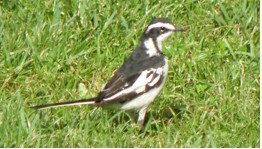
The African Pied Wagtail
Update - all students are accounted for! More sunbirds, yellow weaver finches, white-browed robin chats and wagtails flitter about in the back garden. I walked to the rushing brown stream that cuts through the grounds and a flock of tiny brown finches the size of puff balls landed at my feet but then noticed me and were gone before I could get my camera turned on.
The weather is beautiful – a cool rain cleared the air and dust making it a perfect day for whatever Dickson has in store for us. I think he said we are visiting an orphanage. Our ears are not yet attuned to his accent so we will have to be surprised with today’s itinerary.
The workers at the elephant/rhino orphanage (yes, I thought it was going to be a people orphanage) told us the history of how they got each baby elephant and how they care for them before they introduce them back into the wild. Next stop was “The Bomas of Kenya” which is a reconstruction of the houses of the tribes of the 9 provinces of Kenya. A boma is a village consisting of one man and his many wives and children. The most interesting part of the tour was our guides’ discussion of the different ethnic groups in Kenya and their unexpected unanimous condemnation of female genital mutilation! Our boma tour was followed by lunch of deep-fried chicken and French fries and then a 2-hour dance show in a slightly dark arena. The narrative was a little contrived and repetitive, and I was a very sleepy from the heavy lunch. After an hour of dancing and pounding drums, I was distracted by a tawny eagle out the window opposite - I got a good photo.
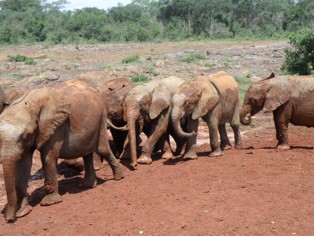
The baby elephant orphanage – they are fed powdered baby formula like Similac.
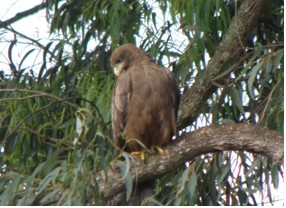
Tawny eagle
December 29, 2009 The Go-away-bird
All students are here but we are missing three pieces of luggage - not too bad considering the delays and cancelled flights due to the holiday and weather. The Maasai Mara awaits us so we buckle into the safari vans and head to Mara Serena Lodge in hopes that the missing luggage will follow us. It was slow going due to vehicle trouble and washed out areas but we saw amazing wildlife at 60 kilometers/hr. We stopped for vehicle repair at a fancy tent lodge and it gave us a chance to walk around and do some birding. A feeling of déjà vu overcame me with the familiar call of the “go-away bird” which sounds just like a child yelling go away! Weaver finches and their hanging nests swing in the breeze and look like huge grapefruit hanging from the acacia trees.
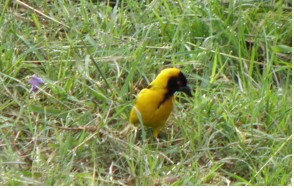
Black-headed weaver
We are delayed about an hour, but then we are on our way - Hakuna Matata – the beautiful landscape surrounds the northern Serengeti; I smile as the students yell out sightings of elephant, topi, gazelle, Tommies, hyenas, and jackals. As soon as we left the city, we notice people dress more traditionally– typically in red plaid robes. Maasai men graze their cattle in what looks like scarred, thorny fields sprouting with new grass after the rains, and groups of women scavenge for fire wood.
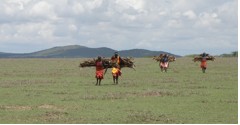
Maasai women gathering firewood
We stopped at a gate and were attacked by bracelet saleswomen – the confusion of hands displayed with trinkets reaching through the windows, and their aggressive sales pitch caught us be surprise, they pushed their wares through the slightly opened window, and we ended up finding odd bracelets and beads on the floor of the van throughout the day. The shops along the way had outrageous prices – expecting that we would bargain them down to something more reasonable, but Americans are generally reluctant to bargain or don’t know how to do it. I felt like a heal discouraging the students for paying $20 for a carved bird or a set of salad servers asI knew they would see better deals as the trip progressed. We were greeted at the Mara Serena Lodge with warm towels and glasses of mango juice and were quickly showed to our delightful cabanas shaped like Maasai huts. The whole lodge blended into the rocky landscape and was tastfully landscaped in mostly native trees and shrubs. The restaurant buffet offered a wide variety of food that appealed to European, American and Kenyan tastes. There are a lot more Kenyan families on vacation than I ever remember from our 2001 trip. We enjoyed playing cards and banana grams until our late dinner. The fish was excellent, however the curried potatoes were my favorite. Of course, I can’t seem to get enough papaya.
December 30, 2009 – Early Safari
The mist was burning off as we loaded into vehicles for our early morning safari, adding a mysterious soft light to the portraits of gazelles, antelopes, waterbuck and the shy eland.
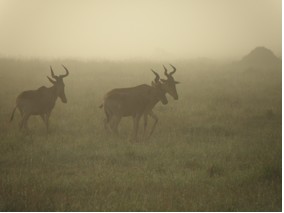
Elan in the mist
We got close-up photos of elephants, but most spectacular were the male lions. A hippo was trotting along the bank of the river so we drove down to the Mara River and spotted six more. The students are learning the Kenyan folk song: Jambo, Jambo Bwane, Habari garu, Mzuri sana, Wageni mwakaribeshwa,Kenya yetsu, Hakuna matata.h
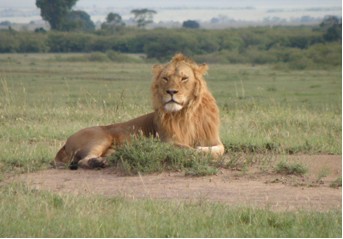
Male lion checking us out
I practiced getting some cool bird shots of the lilac-breasted roller, the heron and of course, the secretary bird. It is no longer obvious today why it is called the secretary bird since most secretaries no longer put pencils in their hair – the students gave the guide puzzled looks as they explained that it was called the secretary bird because of the way it walked. Far off were giraffes and grazing zebras scattered here and there – some of them standing side-by-side facing the opposite direction as they often do . After a safari breakfast of every imaginable item in the buffet, we all took a break from group activities, mostly just relaxing and occasionally checking out the wildlife from our room.
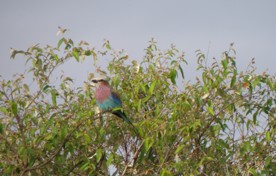
Lilac-breasted roller
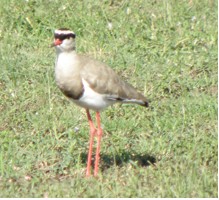
Crowned Plover
The luggage situation looks bleak – maybe one bag will get here tonight, but I’m skeptical. Most crucial is getting mountaineering gear for it is not going to be easy to re-supply and outfit them. I admire the students’ attitude and flexibility. Note to self: next time remind students to wear their boots on the plane.
The second game drive was really the best ever with a good look at a cheetah stalking a topi family. The bird list is growing too, but I am frustrated with no bird book.

My favorite elephant picture
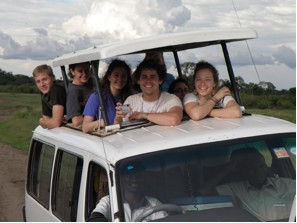
Safari
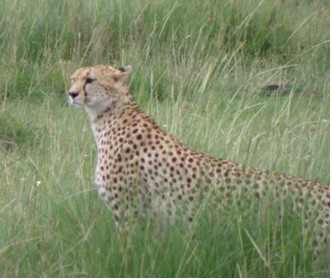
A rare Cheetah sighting
I bought a small bird book in the gift store and am pleased at how many species we have already seen. Because of all the heavy meals and really very little physical activity, it is not surprising that I am not hungry and somewhat lethargic. It does not stop me from enjoying a bowl of creamy squash soup and a piece of turkey for dinner with a cool Tusker beer.
December 31, 2009 - The last day of the year
The luggage situation is not any better and all three are wearing thin on patience – the problem being given false hope by the agents at the airport who appear to just want to end their shifts to celebrate the New Year.
On the all-day safari, our luck was good in that we saw a lioness feeding her cubs even though it took ferrying us in the only all-wheel drive van in shifts to see it. The mud was sucking us into deep ruts and up-socked several vehicles. After the lion cub viewing we had to stop to help get a van (not one of ours) out of the ditch. The driver took a head dive over a ridge and straight into the mud-filled ditch instead of going sideways onto the road. It gave us a rare chance to get out of our rigs and stretch and an opportunity for me to get a close look at the thorns on a “bomb bush”. This acacia has a way of shooting a seed pod that looks like a ball with a few long spikes, kind of like a submarine mine. Elephants can eat them I am told, which is a good thing since they are abundant.
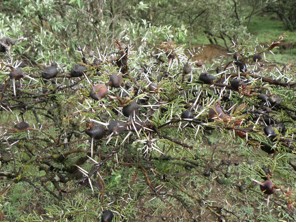
Acacia seed pods (bomb bush)
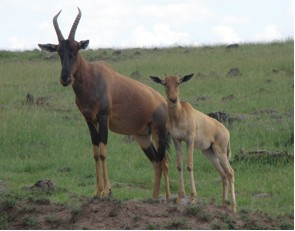
Topi, mother and calf
We enjoyed our picnic on the Tanzania border under a huge fig tree. We were treated to a big box lunch of yogurt, fruit, sandwiches and juice. I took pictures of some interesting wild flowers.
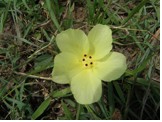
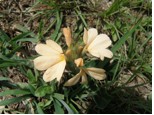
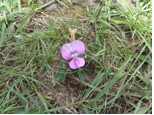
On our way home we stopped to watch a den of baby foxes by the road. It was the bat-eared fox –they looked like a pack of funny little Chihuahuas; they were very cute.
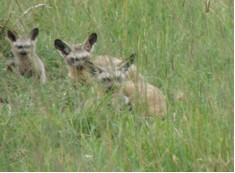
Bat-eared fox kits
The New Year’s Eve celebration was lots of fun with silly hats, party favors, crackers and Maasai robes for everyone. More drums, shaking, and dancing with the students and Phil Evans participating in every dance! The best were the Maasai welcome dancers – jumping and chanting as they paraded past us. Bob and I lasted until 11 then started to “noodle-neck” in spite of the boisterous performers, loud drums, and festive music (one reason they never picked us to dance with them – we probably looked like we would pass out on the dance floor).
January 1, 2010 – The beginning of the end of a decade
I awoke to the sound of the Topicalboubou outside my window. A clear – cell phone-ring-tone sound that makes you smile. The weavers and mousebirds with their cute little pink legs are busy skittering about and preening on the open branch below our window- some of them even perching on the railings on our balcony.
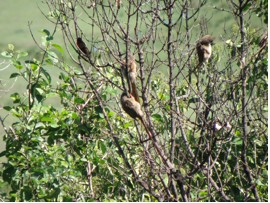
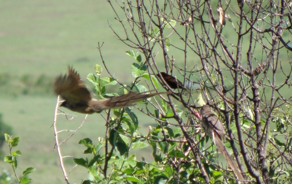
Speckled mousebird
This is a beautiful morning and spectacular beginning to the year. The Tropical boubou couple continues to sing a melodic duet – I finally get a glimpse of them. I was planning to have a leisurely morning of bird-watching but Dickson knocked on the door at 8 and said we should leave in an hour. We had everyone ready to go at 9:30 but the vans did not arrive until 10:15 with no news of the missing bags. Oh well, I think Sara is now resigned to the fact that she will have to figure out how to have a good experience in Kenya without her luggage. We race through the Maasai Mara screeching to a halt when a lion pair crosses the road and once more for a male Kori bustard.
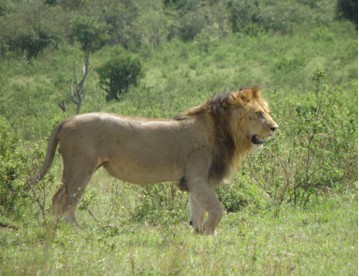
We arrive at the Maasai village; I am surprised to discover that it is a real village or “boma” inhabited by working families. They do the welcome ceremony and jump around the women students holding their hands and dancing joking about how high Aiden can jump – he really kept pace with them pretty well. We entered a hut which had an outside room for the baby calves, kids or lambs whose mothers will be milked. The entry way then curves around to the kitchen and bedroom where the whole family sleeps and cooks. A very small hole on the wall near the ceiling lets a wee bit of light into the very dark room and also lets the smoke out. The bed was a piece of stretched cow hide with a few blankets on top. This is a very busy day for the Maasai and most of the women are heating blood and milk together for a New Year’s feast which they refer to as Christmas. The community school on a nearby ridge seems to have good English teachers. The children are clearly instructed to smile for us and we are permitted to photograph anyone and anything. The $20 is a pretty good bargain considering the photos.
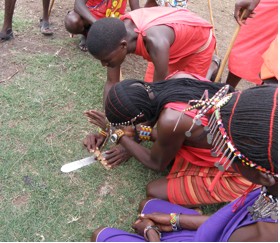
Maasai men show us how they start a fire with a wood spindle.
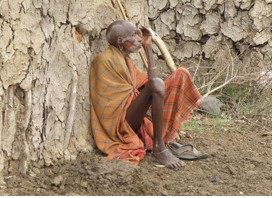
Maasai elder sits by a dung-covered hut.
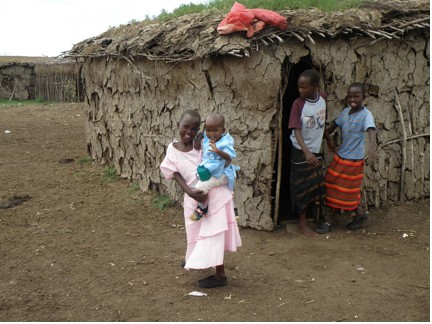
Children dressed up for their New Years Day celebration
We then go to the souvenir corral and get the sales treatment. They are very persuasive.
Lunch is at a curio shop. We race through a rainstorm which is pretty scary and then through the miles of rose greenhouses along the lake to the lovely – but somewhat snobby Simba lodge on Lake Naivasha. The black ibises are just about to roost in their noisy manner, and the open wooded area is home to a heard of waterbuck and dik-dik. A huge stick nest of the hamerkop bird is situated near the restaurant. The trail to the lake is closed for the night so we are confined to the fenced-in grounds.
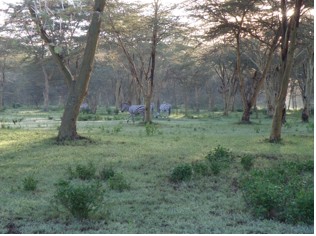
Zebras at the Simba Lodge
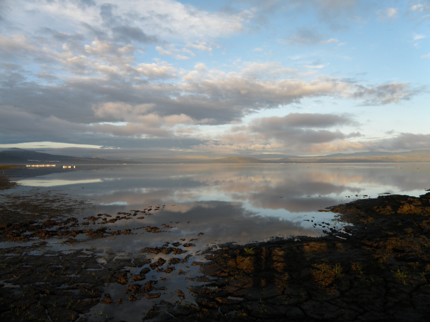
Lake Naivasha at dawn
January 2, 2010 - Longonot and Hell’s Gate – National Parks Kenya style
Bob is still sick – this is day three so he takes a cipro – he has missed some very good meals. Neither of us slept much. The rain woke me up at 2:00 AM. It does not look like a good day for Mt Longonot.
The weather turned out to be okay, only a little rain, and the cloud cover made it a pleasant hike. The steepness and the elevation were exhausting for me. There are no switchbacks; the trails are engineered so as to get you from point A to point B using the straightest route. What I thought was a waterfall turned out to be sandbags stacked like steps going up one of the steep gullies formed I really felt out of shape by the time I reached the crater rim and we still had the summit to tackle. It was a slog to the very top, but well worth it. The way down was slow and steep causing my knee to swell up half way down.
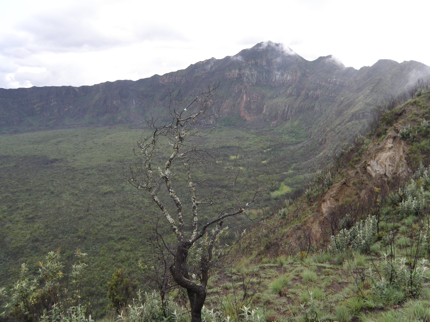
Mt. Longonot –crater rim and summit
Mt. Longonot is a giant caldera with a ragged rim. Our route crossed the fronts of several lava flows before ascending the cone, eroded into parasol ribs. We reached the caldera rim between its low point and the summit. Circling along the serrated knife-edge, we passed a satellite cone and crater on Longonot’s east flank. We bypassed a few minor summits before gaining the high point. Our 360 degree view through the mist included Lake Naivasha and a geothermal facility. It’s exciting to be on a young volcano in East Africa’s rift. Longonot supposedly last erupted in the mid-1880s. The caldera floor is covered by a forest. Because there is no trail down to the caldera floor, I imagine there are indigenous species there.
We decided to take a quick look at Hells Gate National Park near the Simba Naivasha Lodge and stumbled on a treasure! Our quick look turned into 4 hours. The park has animals grazing peacefully amid the spectacular volcanic features. You are struck with a sense of awe at the landscape and scenery. We drove to the Hell’s Gate; I expected to see a canyon or gorge but we were casually led on a steep crumbling trail into a flume of sorts and down a canyon that had been ravished by a flash flood two days ago. The going was rough even by our standards, but we were punch drunk from the exhausting hike up Longonot so the adventure and the unexpectedly dangerous trail reminded us that this was no US national park! No way would a ranger take us down a trail like that. It led us to discussions on liability and a reminder about personal responsibility. One of the problems US parks have is that people assume that they are there for their enjoyment and that they would not be there if they were not safe. Our park ranger said it was a loop trail and the rest was going to be easy but then he took us down another side of the canyon on a narrow eroded path that required sliding on your back, jumping over streams and pools and skillful rock climbing. I found it hard to believe this was the way to Hell’s Gate – I kind of expected some kind of rock formation or panorama which I must have missed as I was trying to figure our where to put my hands and feet as I was moving along. Does he take everyone this way? The canyon was narrow like a flume with colorful layers of volcanic ash. Large boulders, cobbles and gravels of obsidian glistened in the gentle evening light. Waterfalls from a nearby geothermal energy well field surprised us as we waded back and forth across the stream. We came to a wider place that showed the erosion of the flash flood; the floor of the canyon was filled with flood deposits of gravel and sand-sized tuff.
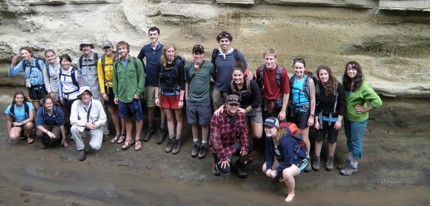
Whitman at Hell’s Gate
The sun was low as we drove past a giraffe family slowly walking in front of a glowing wall of ignimbrite columns. They appeared to be life-like apparitions of the columns themselves. The funny-looking warthogs dashed across the road as they scavenged for their last meal of the day, and a herd of cape buffalo swished their tails as they grazed in a lush field. There was a somewhat ethereal quality to the pastoral scene. We were all ravishingly hungry when we returned to Simba Lodge so we quickly showered and got in line for the excellent rice and stir-fry buffet.
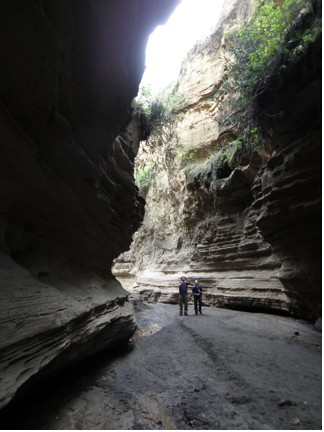
Flood ravished Hell’s Gate
January 3, 2010 - Two buzzes for Leopard
I got up early for a quick walk to the lake with two Simba Lodge attendants. The waterbuck and zebra were up early grazing in the dawn light. The shy dik-dik froze when he spotted us then dashed into the acacia brush as were got our cameras ready. The noisy hadada ibis were starting to light on the irrigation dike in front of us as we approached the lake. Off to the west were two flocks of pelicans their white wings shining in the dawn light – they looked pink so I thought they were flamingos but a closer inspection revealed only dawn-lit pelicans. The streams entering Lake Naivasha are ideal for irrigating the acres of rose farms that literally line the lake with their huge net green houses. They employ a good many people in the Naivasha area but they spew chemicals into the lake causing fish-kills that deplete the food that birds such as the flamingos eat. The lake use to be pink with flamingos, now there are only a few.
We are now on our way to Treetops in the Aberdares. We had two quick stops, one at Thompson’s Falls which were pretty impressive and gave us a chance to meet Kikuyu people in traditional dress and chameleons, and then another at the equator where we saw a demonstration of the Coriolis effect – done with some magic, water and a match stick. We passed on paying the 3 bucks for the certificate verifying our visit to the equator and headed on through villages which seemed busy with vegetable road-side stands of potatoes, onions and some fruits. The signs painted on the stucco buildings are interesting; the theme has changed from coke and alcohol to cyber cafe, phone charging places that are combined with beauty parlors and butcher shops.
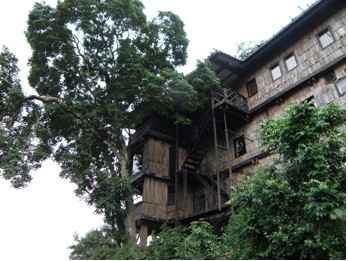
“Treetops”
Okay - the Treetops hostel is a bit odd – in a good way. It used to be a tree house built by a Mr. Sherwood who started to notice that all the big game animals were disappearing; the Aberdares were the most popular place for all the macho big-game hunters. The black rhino was nearly extinct - so he had a brilliant idea to build a tree house and introduced photo safaris. Queen Elizabeth was up in that tree house when she learned that her father, King George died. It was burned in the Mau Mau rebellion (1952-60) so he re-built a hostel on stilts with some tree supports that exists today. It is hard to get any luggage up the spiral staircase so that is why they wanted us to leave it at the lower Treetops hotel, which would have been okay except this was our night to sort bags. We went on a two-hour safari but saw nothing new except the bush hog. Treetops is over
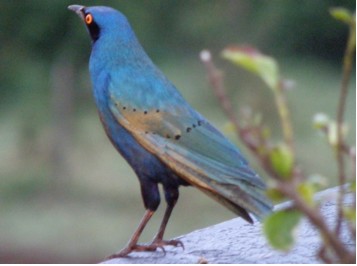
Blue-eared starling
a watering hole but I think the animals are lured here with salt as well because it weird that they would frequent a watering hole next to a huge hostel. We had a quick lecture by Stephen who told us the natural history of elephants. They nurse their babies until the tusks get in the way at age 5 or so. They usually have two babies nursing at the same time about 4-5 years apart in age. The males are shunned from the herd at puberty and go off and form a male-bonding thing that establishes dominance with fighting and a weird sexual domination ritual.
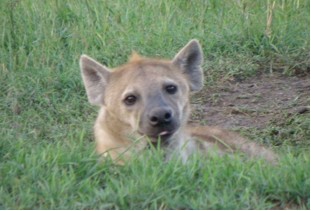
Hyena looking forlorned
He ended his talk by saying that we all had buzzers in our room and that he would buzz us once for hyenas, twice for leopards, three times for a rhino, and four times for lots of elephants. There were lots of hyenas growling and loping about so we were hoping he would not buzz us every time one loped in but he did. I dreamt I heard a two-buzzer leopard call and raced out to the water hole wrapped in a blanket, but only the crowned crane and the Egyptian goose were there squawking in the moonlight.
January 4, 2010 – Leaving Mud Tracks at the Watering
I woke at 5:45 and dressed and went to the waterhole viewing place, got a cup of tea and watched the Egyptian geese and goslings and a big bull cape buffalo until the others appeared. The bull was acting peculiar not that I know what the normal Cape buffalo behavior is, but he kept licking the red clay and then occasionally looked up at me in the viewing window. This reinforced my theory that they put out a salt lick to attract the animals since the watering hole does not look that special.
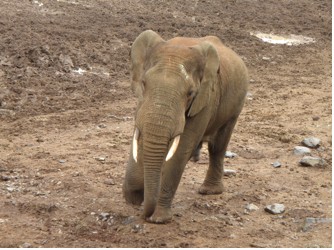
Elephant at the watering hole
We piled our enormous amount of luggage into the Treetops bus and squeezed all of us in for a ride to lower, fancier Tree Tops Hotel for breakfast – it was a nice variety of baked beans, bacon, eggs, crepes and rolls – the usual. We finally got loaded in the vans and went to Chogoria to have lunch and get into the 4x4 vehicles.
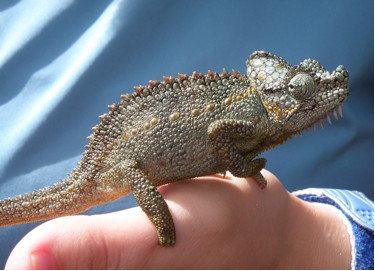
Chameleon blending with Laura’s blue shirt
The rains were the big news on the front page of the newspaper – and the road up to the drop-off point was rutted and looked impossible to navigate, but the jeeps pushed on sliding, getting stuck in the ditches on the side several times. When people get stuck here they just keep spinning their wheels in the mud until the rubber melts. We made a few stops to see the camphor tree and the big oaks. The ride was gut-wrenching and bone-jarring the whole way and we were relieved to get out and walk about 4 km up 1500 feet to this amazingly cool camp called Bandas. On our way we went from the thick forest of huge oak and rosewood trees through the bamboo forest with scattered podocarpus, fields of huge, tree-like St. John’s wart and a beautiful composite flower with huge elephant and cape buffalo poops on the path. We were so hungry upon arriving they fed us tea and cookies - the English digestive biscuits that taste so good after hiking. We have beds and showers and lights at this camp. The view of Mt. Kenya revealed itself at sundown. Dinner at 8:30 - it’s getting cold!
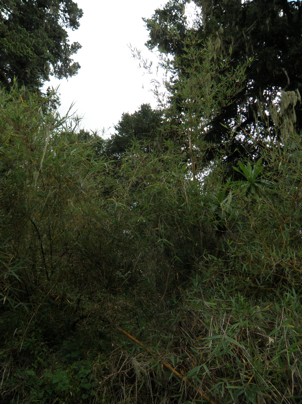
The impenetrable Bamboo forest
.
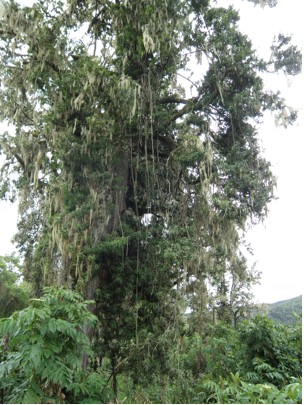
Podocarpus falcatus
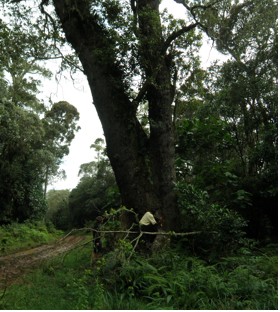
900-year-old Camphor tree – Ocotea usanibareusis
Dinner started with a wonderful soup made with squash and white beans and then over-sized portions of mashed potatoes, stew, a spicy cabbage –cilantro salad were dished out to us. Tiny sweet bananas and papaya were for dessert. The temperature dropped as I tucked in my bed so I got up and snuggled into my fleece liner. I woke at 4:30 a.m. probably due to altitude.
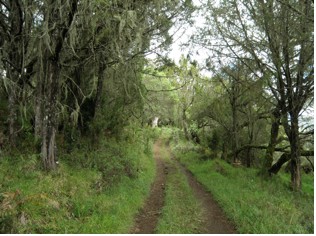
Cedars, Juniperus procera with epiphytic lichens
January 5, 2010 Bandas – First View of the Sacred Mountain, Mt Kenya
I dodged cape buffalo droppings on the way to the lodge for breakfast. The lovely golden light danced on the gnarled rosewood trees that stood in front of our hut. It is quickly getting
warm enough to take off a few layers. Breakfast was cereal, eggs, toast, crepes and sausage. The plum jam and peanut butter were delicious.
Before starting on our trek, we were all introduced to our porters and guides and watched as they divided up our embarrassment of luggage. I think my bag is okay weight-wise, however the wheels make the bottom part hard; big yellow is heavy and awkward, but
soft. After about ten minutes I started to feel my pace and then I got into the “zone” that I was hoping would kick in where my heart rate and breathing are synced. I stopped panting and I have an even pace – much easier than yesterday.
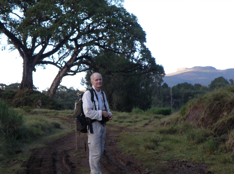
Bob starting up Mt. Kenya
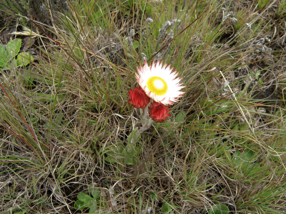
A species of straw flower
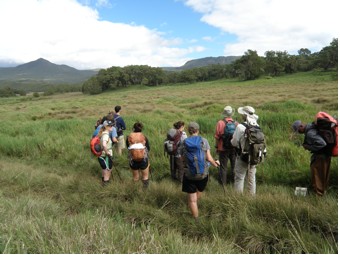
Entering the paramo
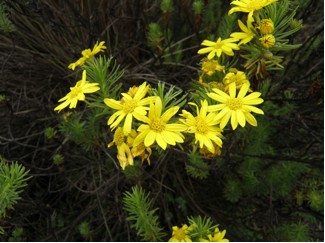
Euryops brownei
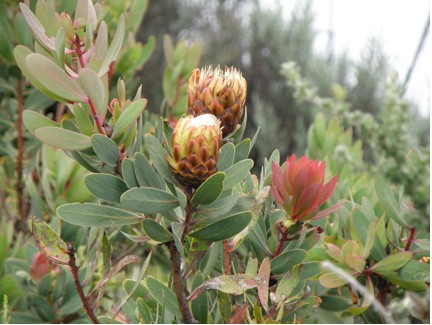
Protea
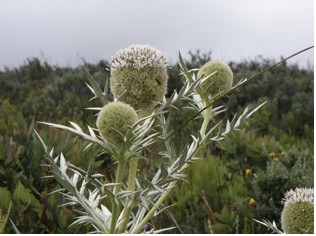
Indigenous thistle

Figwort species?
January 5, Nithi Camp
The Nithi River which falls at least three times over resistant agglomerate forms a dramatic landscape and spectacular vistas from our tent site. Another river shoots through a very narrow canyon so that it appears to be coming out of a cave in the middle of a cliff. We hiked down to the falls then back up and over to the caves and other falls.
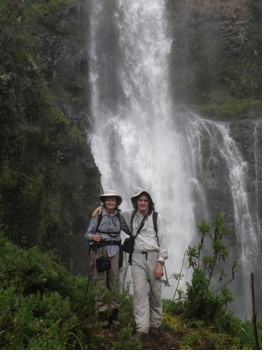
Bob and I at Nithi Falls
Our porters were camped under an overhang next to the falls; Festus said that the freedom fighters (during the Mau Mau independence fight) camped at this site but that there were no known archeological sites there. Japhit, one of our guides, has been working on Mt. Kenya for over 20 years and keeps a notebook with neatly written notes on plants. He pointed out a tree that has no known English or Latin names – it has a leaf like a madrona; the dried berries are good for stomach aches.
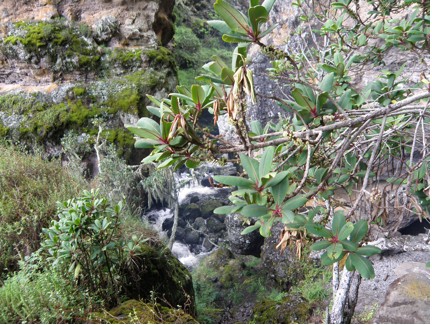
Japhit’s Tree
When we returned, we washed up and were treated to popcorn and cookies with our tea. The camp is in the heather senecio /groundsel area. We saw lovely Protea as well as flowering small groundsels. Small brown chats and wheatears sing to us as we make our way back to camp. Two red-winged starlings with long boat tails were poking around looking for crumbs. This is our first night in tents – I’ll see if I survive – the pads are pretty thin.
January 6, 2010 Lake Michaelson
I felt like I was sleeping on a rock – normally I can curl around such tent-floor obstacles but this one was too big so I was bowed and woke up many times stiff. The students were jovial, and having a lot of fun so it was hard to sleep at first. Breakfast consisted of thin porridge with peanut butter and jelly mixed in. Then we were served French toast and sausage. We were given a sack lunch with one butter, cucumber, onion, and tomato sandwich and one butter-and-cheese sandwich, and a banana. I packed a Necco roll and fiber-one bar in my pack as well; we were really burning a lot of calories.
This was the hardest day yet, but we had spectacular views of hanging valleys waterfalls and glacial valleys. I think we gained 3000 feet in about 12 km and 6 hours. Camp is at 13,000 feet now on the shores of the serene Lake Michaelson. Beautiful lobelia, gladiolas, senecio, and clumps of bunch grass line the lake. Many of us have symptoms of altitude
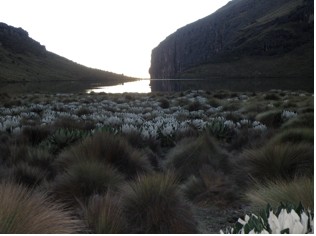
Lake Michaelson with megaphytes (Senecio brassica) at dawn
sickness- headache and nausea, but it should go away since we dropped 1000 feet to camp per the “climb high –sleep low” rule. It turns out that Mintos camp is just above us. If you take that more direct route you don’t have to lose elevation but then again you don’t get acclimated as well either. Dickson says we are doing well.
Dinner is pasta and veggie stew (easy to digest and filling) with mango and oranges for dessert.
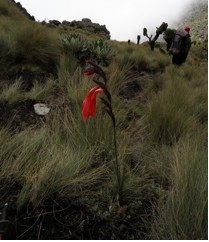
Gladiola
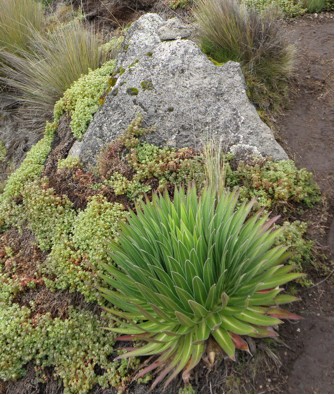
Massive leaf rosettes of Lobelia species
January 7, 2010 Camp high, climb higher
We ate breakfast of wheatabix and pancakes with omelets as we watched the sun light the lake, the cliffs behind us, then us. This was the coldest morning – our tents were all frozen stiff and bit of ice clinked down on me as I got out of my sleeping bag. After we warmed up a bit, we stripped out of our cold gear and started up the valley following the Nithi River climbing high up a series of waterfalls. Then we came to another valley that looked like a marsh – British camp. The malachite sunbirds flittered about the lobelias and a huge thistle-like plant that is endemic to Mt. Kenya.
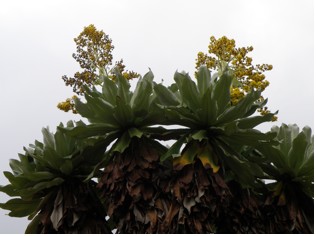
Giant Groundsel tree Senecio keniodendron – they bloom every 20 years.
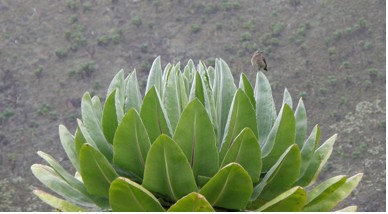
Alpine sunbird
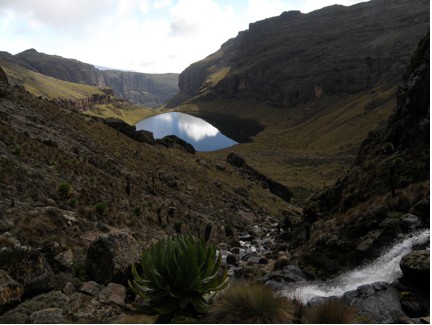
Looking back at Lake Michaelson
I can see Nelion and Bation and Lenana through the mist – Simba Col and Simba Tarn are our next high points. From there we see the route up Lenana and way below us across a tricky talus slope, moraine, and several bolder fields, we see our camp. Bob and I can’t imagine traversing this slope again to climb Lenana in the pre-dawn darkness so we have a meeting with Phil and the guides to come up with a better plan. Bob is exhausted because of the beta blockers and I feel exhausted, but I am not sore and have some energy. This is not what I imagined the hike to be, although I must admit I never really read an account of it. The reality is that you climb a mountain everyday except the first. Going to Bandas was easy, but the road was rough, Nithi was more challenging and we told ourselves that the other days would be probably be easier except for the summit day. I am glad we are not walking completely around it as planned. It was made to sound so easy, but the reality is, the path is steep you are altitude-affected and cold. I just want to go up then come down, getting warmer and warmer as I descend like other mountains. I love the dramatic landscape, but feel pretty tired. I am the last one to hike down (yes down!) to Kami Hut camp arriving at about 1:30 PM as the cooks were serving up plates of pork and beans with peppers and coleslaw sandwiches. Watermelon (who hauled that up?) was a welcome dessert. My fingers are getting too cold to type – I’ll finish up later.
We hope to summit tomorrow morning so we are going to get up at 3 and leave by four. Dinner was spaghetti with a thin beef stew. It is very cold.
January 8, 2010 – Getting high with a little help from my friends.
I slept for about an hour then woke with a back spasm. To make things worse, I had taken a diamox earlier and had to pee. I could not sit up without extreme pain. It took me much effort to get to my pack where there were ibuprofen tablets. I thought if I could let the medicine take effect I might be able to get out of the tent. At 12:30, the pain got worse and I was trapped in my mummy bag with tent claustrophobia - not able to get into a position to get up. I woke Bob to help me get out and it took about a half hour to get me to a standing position with boots loosely on so that I could get out to use the bathroom – so to speak. The realization hit me that I was supposed to start climbing a very difficult mountain at 3:00 AM, and I knew from looking at the boulder field below me that it was not going to happen unless I could get rid of the back spasm - I got out the 600 mg Ibuprofens and took one. The sky was a dome of stars and a quarter-moon lay on its side high above. I felt like I was in a diamond cave – everywhere I aimed my head lamp glistened with ice crystals and stars. The frozen moisture in the air drifted like diamond dust. I returned to my warm sleeping bag fell asleep for two hours; then we got the call to wake up for tea, porridge and cookies. I could move a bit better by this time but I was feeling nauseous due to the excessive amount of ibuprofen and the porridge was slightly scorched- there was no way I was at my normal pace on this longest of hikes. The students were excited and ready to do it; they took off about 10 minutes before Bob, Phil and me. We headed down to the bottom of the talus field so that we were not crossing slippery boulders in the dark. The ground was crunchy with needle ice - the normally loose scree was frozen and a lot easier on which to get a good footing. At 14,500 feet every step is an effort so you want your foot to stay where you put it. I could not get a pace going due to my back and the varying ups and downs of the terrain, and little visibility for more that a few feet in front of me. My back hurt with each step. I just followed Festus who patiently waited every time Bob or I stopped to pant or every time I had the urge to throw up. We finally made it to the moraine where it was easy to see a path which did wonders for my motivation. Phil left us at quicker step with Dickson – he caught up with the stream of student headlamps twinkling diagonally up the slope. As difficult as it was, it was the most beautiful sight to behold. The peaks of Nelion, Batian, and Lenana were silhouetted against the star-lit sky - their patches of snow reflecting my head light. We could tell we were approaching Simba Col where we were yesterday afternoon. The trail up Lenana split before the col and was even and switch-backed which is always easier for me. The sky in the east was rosy just as we made it to the base of the peak. We turned off our headlamps and started climbing through the rocks and spires.
. 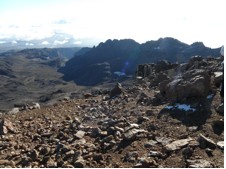
View from the summit
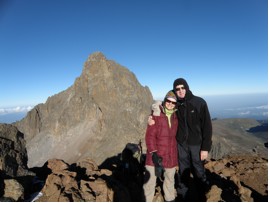
On top!
Finally, a little rock-climb to the summit where all the students were cheering and formed an arch that we walked through. Phil surprised us with the bottle of champagne that he won at the New Years Eve party in Serena Lodge – I can’t believe that he hauled it this far! The sunshine and views from Lenana were well worth every second of the trip. Everyone was giddy with our accomplishment. Bob and I were the last ones off the summit making our way down to a breakfast at the Austrian hut of French toast with African sugar – the best I had ever had.
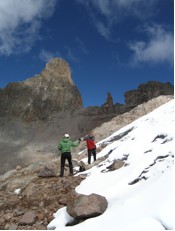
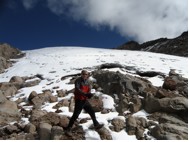
Students on the Lewis Glacier
After a short hike to the Lewis Glacier where Bob gave a short talk and took some awesome pictures of grooves under the glacier, we descended in search of more O2.
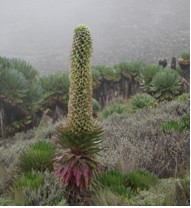
Lobelia species (teleckii?) in bloom
I limped into Mackinder’s camp named for Sir Halford John Mackinder who was the first one up Batian in 1899. It was dry all afternoon; we had striking views of the Darwin and Diamond Glaciers that looked like they were going to cascade down a cliff. The cooks served top ramen and bread for lunch; later in the afternoon, they brought in trays of popcorn and homemade doughnuts with tea. I was very hungry in spite of all this food and enjoyed a bowl of their famous hot cucumber onion soup – I scooped the rice from the main course on top and skipped the beef stew, which was getting a bit repetitive. I got into my bag at 7 PM. and was asleep at 7:15 having taken a half of a muscle relaxant pill for my back.
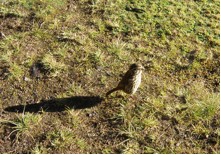
Wheatear
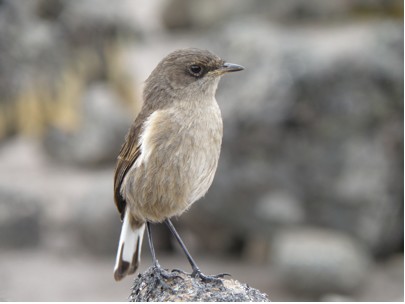
Alpine chat
January 9, 2010 - “Busting ass down the mountain”
I slept 9 hours and felt pretty good in the morning. I forced down a wheatabix and a pancake although I was not very hungry. We had cocoa which is a treat for us. It took us five hours of skipping over rocks and poling through muddy puddles; I carefully followed Festus through the paramo and vertical bog hopping from one cushion plant or clump of grass to another. It was a relief to get to the megaphytes of lobelia of the lower elevation.
The light is lovely after a thunderstorm. Unfortunately I slipped not on the obvious steep vertical bog, but on a slick rock on the relatively level part. My feet went out from under me and knocked the wind out of me. I probably broke something in my lower back. I can barely move and am not sure how I will make it the 9 Km out tomorrow. I was already feeling pains in my neck and stiffness in my back from the spasm before the fall. Lunch was a bean stew with cucumbers. It’s time for a nap.
Dinner was a vegetable stew with bread that is nan-like except it is fried and served with salt. Dessert was passion fruit, which I like. It is a small golf-ball sized fruit that is easy to break open with your fingers and scoop out the gelatinous covered seeds that you eat whole. They look a bit like frog eyes, but once you get past that it is really good. The ones that we have been served are tangy and slightly acidic – tonight I stirred a few scoops of seeds in my tea – making it a very a lot like the red zinger tea. I love the Kenyan tea; it is mild and naturally sweet. We are in the tea growing area near the Aberdares and watched as it was being picked. All our meals have been simple and nutritious with lots of fresh fruits and vegetables. After dinner the students told stories of their first kiss which was very cute.
January 10, 2010 First kiss
I had a rough sleep but at lest the pain medicine works to get me moving and in and out of the tent. It rained most of the night and that combined with feeling like I was pinned in my mummy bag, forced me to turn the headlamp on several times to quell the tent claustrophobia. I was relieved when the tree hyrax and the Columba monkey announced the arrival of dawn. It was still cloudy but not raining as it was throughout the night. Met station is really nice with several huts and a cooking place and an overhanging porch for eating. It is surrounded by rosewood and podocarpus trees. The Sykes monkeys are hilarious as they try to steal our soap and other things lying around. The porters got a kick out of one of them chasing Jacob. “They are not afraid of white people.” our guide said. Also in our camp are 8 climbers from Spain. They were hoping to climb Bastion using an ice route. They were disappointed when we told them that the last time someone ice-climbed Bation was in ’05. Climate change has dramatically affected the glaciers on Mt Kenya. We could see the shrinking Lewis Glacier; Dickson showed us where the glacier was 15 years ago. The Spanish climbers are going up and down the Mackinder’s route which is too bad since it is not the most scenic - the Chogoria route is so beautiful – but I think the Spaniards are all business with climbing – they intend to also climb Kilimanjaro and Meru.
We set out to hike 9 Km to the gate to be picked up. The students went first and I started out slowly before Bob, Dickson and Festus. I wasn’t sure how far I could hike – I’m pretty sure I fractured my tail bone when I slipped on the rock. The pain medicine that I took at 6:00 AM was starting to wear off which was better for my balance on the steep road that had deep muddy ruts. I was very weak at times even though I had 4 pieces of French toast with raw sugar for breakfast washed down with 2 cups of tea. We met a troop of baboons on the way being careful not to provoke them. I did not think that I would be able to run from them. We also saw lots of fresh tracks and droppings from elephant, cape buffalo, and hyena. Bob and I were greeted again by all the students lined up creating an arch that we marched through as they clapped and stamped their feet. Then we ceremoniously tipped the porters/ cooks/ and assistant guides. One of the guards at the gate stood in line to pretend he was a porter and everyone laughed. We were transported via land rovers to Naro Maru Lodge - a very welcome reprieve with hot showers (after some moving around) and relaxing naps with the lovely gardens and birds. We all celebrated with a much-deserved Tusker and a delicious dinner.
January 11, The long day
We enjoyed a leisurely breakfast of crepes and omelets and then loaded our gear onto the bus for Nairobi. The customary dinner at the Carnivore was a good celebratory farewell. The restaurant no longer serves exotic game – only ostrich and crocodile which are farm raised – I knew the day would come.
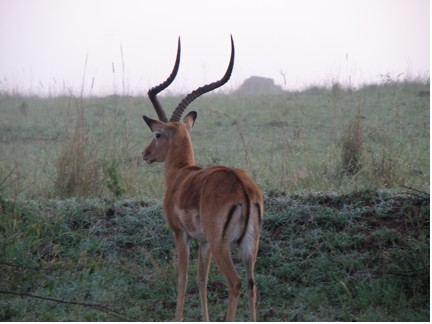
The End
Appendix I - Bird list
- Ibis, Hadeda
- Ibis, sacred
- Sunbird, amethyst
- Sunbird, beautiful
- Sunbird, variable
- Sunbird, alpine
- Stork, marabou
- Stork, white
- Stork, yellow-billed
- Kite, black
- Eagle, Tawny
- Eagle, African fish
- Go-away-bird, bare-faced
- Chat, white-browed robin
- Chat, northern anteater
- Chat, alpine
- Ostrich, common
- Bustard, Kori
- Roller, lilac-breasted
- Owl, giant eagle
- Heron, grey-headed
- Cuckoo
- Secretary bird
- Plover, African wattled
- Plover, blacksmith
- Plover, crowned
- Plover, kittlitz’s
- Guineafowl, helmeted
- Guineafowl, vulturine
- Spur fowl, red-necked
- Mousebird, speckled
- Goose, Egyptian
- Yellow-throated longclaw
- Crowned crane
- Starling, metallic blue
- Starling, greater blue-eared
- Egret, great white
- Egret, cattle
- Hamerkop
- Buzzard, augur
- Whydah, pin-tailed
- Whydah, Eastern paradise
- Crow, pied
- Coot
- Pelican, great white
- duck (black unidentified)
- Peahens
- Bulbul, yellow-vented
- Seedeater, streaky
- Widowbird, long-tailed
- Gull, grey-headed
- Boubou, tropical
- Oxpecker, red-billed
- Dove, African mourning
- Hornbill, southern ground
- swallow, barn
- swift
- Wagtail, African pied
- Wheatear
- Weaver, black-headed
- Weaver, beglafecht